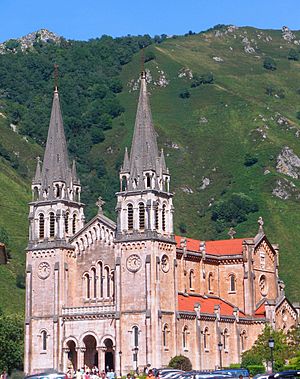Basílica de Santa María la Real de Covadonga facts for kids
Quick facts for kids Basílica de Santa María la Real de Covadonga/Cuadonga |
|
|---|---|
 |
|
| Location | Covadonga/Cuadonga, Cangas de Onís/Cangues d'Onís, Asturias |
| Country | Spain |
| Denomination | Basilica |
| History | |
| Status | Basilica |
| Dedication | Our Lady of Covadonga |
| Consecrated | September 11, 1901 |
| Cult(s) present | Catholic |
| Architecture | |
| Functional status | Active |
| Architect(s) | Roberto Frassinelli (design) Federico Aparici (construction) |
| Style | Neo-Romanesque |
| Groundbreaking | 1877 |
| Completed | 1901 |
The Basílica de Santa María la Real de Covadonga is a beautiful Catholic church in Covadonga/Cuadonga, Asturias, Spain. It's also known as the Basilica of Holy Mary, the Queen of Covadonga. This special church was named a basilica on September 11, 1901.
A German architect named Roberto Frassinelli designed the church. It was built between 1877 and 1901 by another architect, Federico Aparici y Soriano. The basilica has a Neo-Romanesque style, which means it looks like old Romanesque buildings. It's built completely from pink limestone, giving it a unique color.
Contents
History of the Basilica
Building a New Church
In 1777, a big fire destroyed the old church. This old building was next to the Holy Cave. The Holy Cave is a special place where Our Lady of Covadonga is honored. After the fire, people decided to build a new, grand church. They collected money from all over Spain for this project.
However, the local council didn't agree with the plan. The church leaders wanted to rebuild the old temple in the Holy Cave. They also wanted to build a very large sanctuary that a famous architect, Ventura Rodríguez, had designed a long time ago. But that big plan was never finished.
A King's Interest
About 100 years later, Alfonso XII, who was the King of Spain, became interested in the project. He wanted to see the new church finished. The original design by Ventura Rodríguez was very complex and expensive to build. So, they decided to use a new design that looked like medieval buildings instead.
This new design was created by Roberto Frassinelli. People called him The German of Corao. He was more of an artist than an architect. Later, Federico Aparici y Soriano took over the construction. He had studied at the Royal Academy of Fine Arts of San Fernando. Even though Aparici was in charge, Frassinelli still helped direct the building work. The basilica was completed in 1901.
Things to See on the Esplanade
The esplanade is the open area in front of the basilica. Here are some interesting things you can find there:
- La Campanona: This means The Big Bell. It's a huge bell, three meters tall, made in 1900. It weighs 4,000 kilograms (about 8,800 pounds). An Italian count named Sizzo-Noris donated it.
- Bronze statue of Pelagius: This is a statue of Pelagius, a very important historical figure. It was made in 1964 by Eduardo Zaragoza.
- The Obelisk with the Victory Cross: This tall monument was built in 1857. It was created by Philippe d'Orléans, who was the Duke of Montpensier. People believe this spot is where Pelagius was crowned as the first King of Asturias.
- San Pedro Monastery: This old monastery is considered a Bien de Interés Cultural, which means it's a protected historical site. It was founded by Alfonso I of Asturias.
See also
 In Spanish: Basílica de Santa María la Real (Covadonga) para niños
In Spanish: Basílica de Santa María la Real (Covadonga) para niños
- Asturian art
- Catholic Church in Spain

